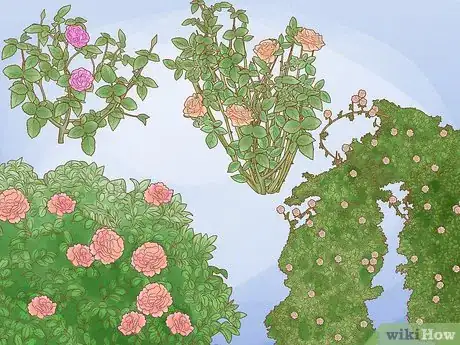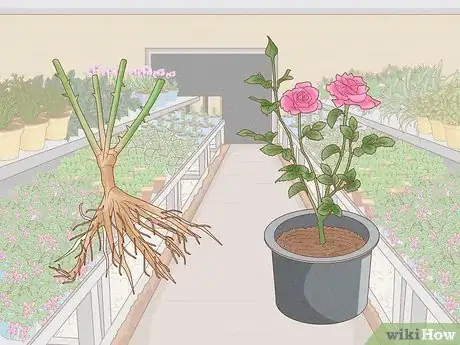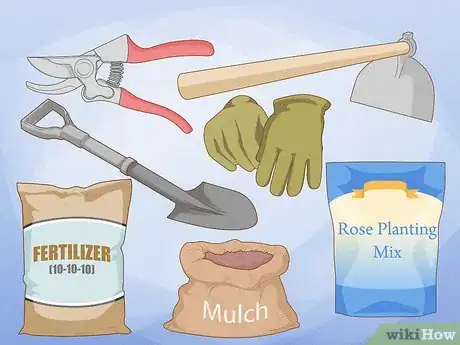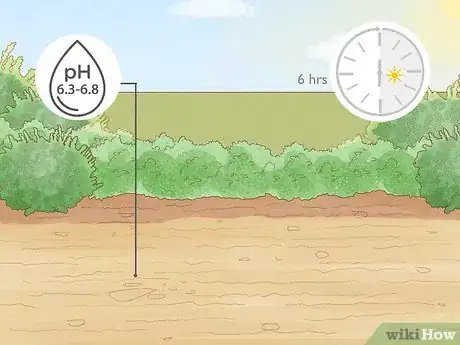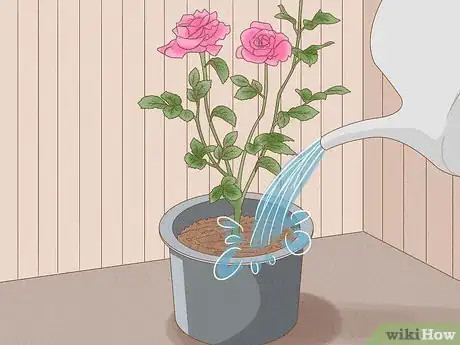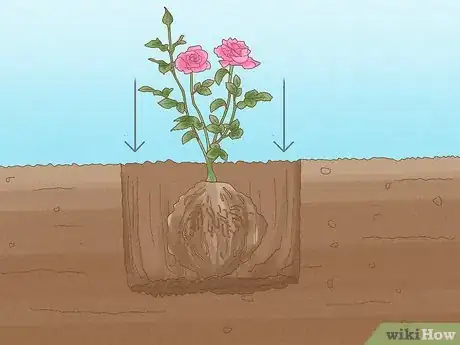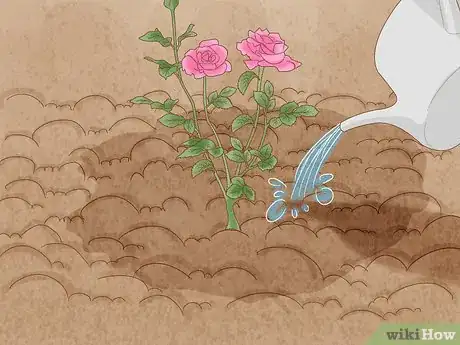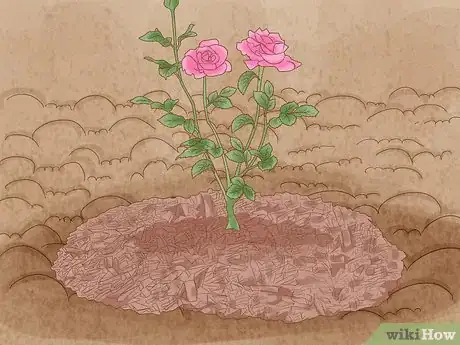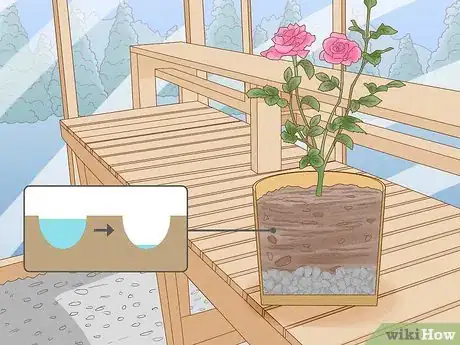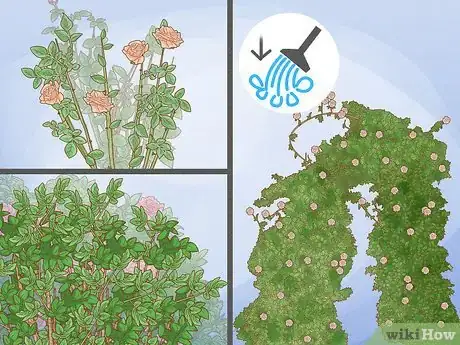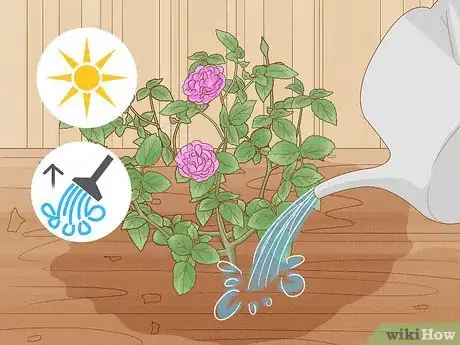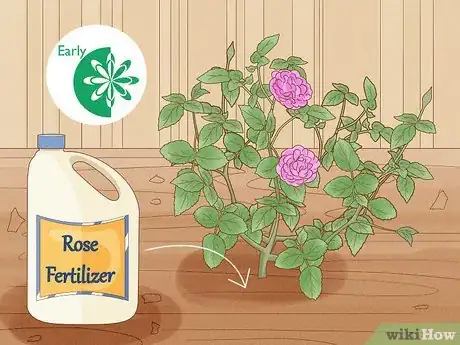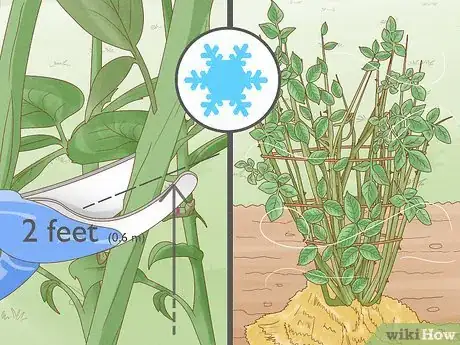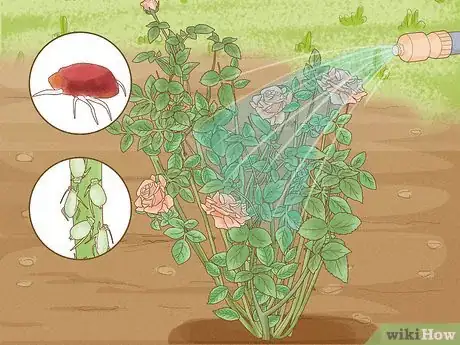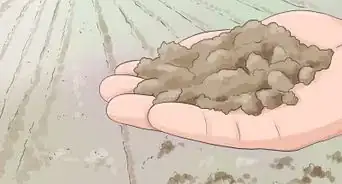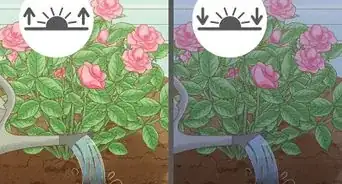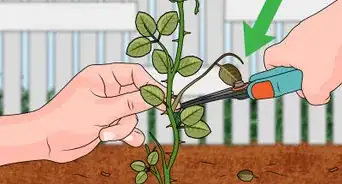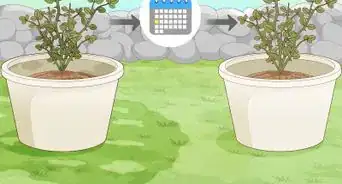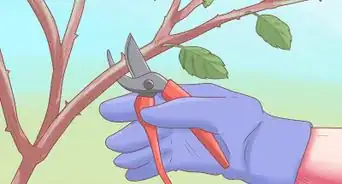This article was co-authored by Artemisia Nursery. Artemisia Nursery is a retail plant nursery in Northeast Los Angeles specializing in California native plants. Artemisia Nursery is a worker-owned small business with plans to become a worker-owned cooperative. In addition to California native plants, Artemisia Nursery offers a selection of succulents, heirloom veggie and herb starts, house plants, pottery, and gardening tools and supplies. Drawing on the knowledge of the founders, Artemisia Nursery also offers consultations, designs, and installations.
wikiHow marks an article as reader-approved once it receives enough positive feedback. In this case, 100% of readers who voted found the article helpful, earning it our reader-approved status.
This article has been viewed 383,030 times.
Would you like to become a Rosarian? Roses, symbolic of love and beauty, have been growing wild and in gardens for thousands of years. To grow gorgeous roses, it's important to choose varieties that grow well in your region and take measures to help them thrive season after season.
Steps
Preparing for Planting
-
1Choose rose varieties. Did you know there are 13,000 varieties of roses?[1] Some roses grow better in certain regions than in others. When you're choosing what type of rose to grow, take some time to research the specifics of your growing region, then look for roses that have characteristics you find appealing. Take their shape, size, and color into account when choosing varieties to grow. Roses fall into the following categories:
- Hybrid tea roses are beautifully shaped, colorful roses that often make appearances in flower shops and as part of bouquets.
- Floribunda roses are the most colorful of all the varieties. Each bush has many blossoms, rather than just one to a stem.
- Grandiflora roses are a cross between the hybrid tea and Floribunda roses, and they grow to be quite tall with several rose clusters to a stem.
- Climber roses can be trained to stretch vine-like along fences and walls.
- Miniature roses are intricate and tiny, perfect for planting in a container.
- Shrub and landscape roses are quite hardy, resistant to pests and disease. They come in many colors, shapes and sizes.
- Tree roses are roses that have been grafted to a long stem, giving them the appearance of trees. They require a bit more care than some of the other types of roses.
-
2Buy bare root or potted roses. Once you've picked out the types of roses you want to plant, decide in what form you want to buy them. Bare roots are the roots of roses that are planted directly into the ground. You can also buy young roses that have already been planted in a small pot, and transplant them to the ground or another pot. Either type may be purchased in a nursery. Rare rose varieties may be found online.
- Bare root roses are planted in early spring, giving them time to take root before sprouting several weeks later when the weather warms up.
- Potted roses can be kept inside during the winter, then placed outside in the spring.
Advertisement -
3Get rose gardening supplies. Aside from the bare root or potted plant itself, you'll need a few other supplies to get your rose garden started. Go to your local nursery or check out online retailers to pick up the following:
- Pruning shears. Pruning roses keeps them healthy, promotes the growth of blooms, and keeps them in a pretty shape. Shears are essential equipment for growing roses. Get small curved-edge shears and larger lopping shears.
- Gardening gloves. Protect yourself from thorns with a thick pair of gloves.
- Fertilizer. Roses should be fed with fertilizer a few times a season. You can buy fertilizer specifically formulated for roses, but this is not strictly necessary.
- Mulch. Mulching rose beds can help keep pests away and distribute more nutrients to the roses. Get wood chips, pine needles, peat nuggets, or another type of mulch suitable for your area.
- Compost or rose planting mix. Mixing this with the soil when you plant the roses helps them grow.
- A shovel and spade. You'll need these to dig holes when you plant the roses.
Planting Roses
-
1Decide on a planting spot. You'll need a spot that gets at least 6 hours of good sunlight a day. Choose a spot that's not crowded with the roots or branches of other plants and trees.[2] The soil should be loose and have good drainage; if yours has a lot of clay, loosen it and add some gypsum pellets before planting.
- Roses do best when the soil has a pH of 6.3-6.8.[3]
- To determine whether a site has good drainage, walk around it after a good soaking rain. If the soil is damp, but not waterlogged, it should be fine. If you see puddles or large mud spots, you'll need to find another site or work on this one to make it more conducive to growing roses.
-
2Water the roses to prepare them for planting. If you're planting bare roots, soak them in a bucket of water for a few hours before planting. If you're planting a rose you bought in a pot, water it thoroughly before you prepare the planting bed.
-
3Prepare a large hole. You'll need one for each rose bush you're planting. Use a garden spade or shovel to dig a hole 18 inches (45.7 cm) wide and 18 inches (45.7 cm) deep. The measurements don't have to be exact, but a hole this wide and deep will be suitable for most roses. Mix the soil you removed from the hole with compost, and use some of it to form a small mound in the base of the hole. Add some bonemeal or rose fertilizer.
- If you're planting more than one bush, allow several feet of space in between, so the roots have room to grow and stretch.
-
4Plant the roses. Place the bare root or potted rose on top of the mound. Use a shovel to fill the hole back up with soil. The rose's bud union should be located about 2 inches (5.1 cm) below the surface of the ground. If you live in a colder region, you may need to plant your roses deeper to protect them from low temperatures.
- If you're planting a potted rose, loosen the soil around its roots to expose them before planting it in the hole.
- Make sure the soil is firm around the roots; press down with your hands to remove any air pockets.
-
5Water the roses. Thoroughly watering the area where you planted the rose helps compact the soil against the roots, stabilizing the plant. Make sure it gets a good soaking right after you're finished planting.
-
6Add mulch to the rose bed. Place mulch over the area where you planted the rose. If you planted a potted bush, place the mulch around the stem. This will keep the temperature consistent and protect the roses during the early stage of growth.
-
7Grow your roses indoors, alternatively. You can also raise roses in a greenhouse. You’ll need containers that are at least 9 inches (22.9 cm) wide. Spread 1 to 2 inches (2.5 to 5.1 cm) of small pebbles at the bottom of each pot to ensure good drainage and fill each with halfway with well-draining soil. Plant the roses just beyond the graft point and then water well.[4]
- Place your containers somewhere sunny in the greenhouse and arrange them so that the roses don’t shade each other out. They will need at least 6 hours of direct sun per day.
- Prune the plants severely after planting, trimming each branch back about 3 inches (8 cm) from the main stem.
- Water the plants so that the soil stays slightly moist, but don’t allow the water to touch the stems or leaves. Mulch the containers with a 2-inch layer to retain moisture in the soil, and fertilize the plants with water-soluble rose food every two weeks once new growth begins.
- Keep your greenhouse temperature at around 60 °F (16 °C) during the day and 40 degrees at night for optimal growth.
Caring for Roses
-
1Be aware of your variety’s needs. Rose care will depend a lot on the variety you’re raising. Some roses like William Baffin and Lady Hillingdon climbing roses are more drought tolerant, for example, while others need more water. Some varieties can withstand less sunlight than others. Rose varieties should also be pruned differently depending on the variety and your climate area.
- Be sure to read up on the variety of rose that you are raising and know what it needs in terms of care. A hybrid tea rose has to be pruned back much more severely than a floribunda, for example, while old garden roses need only light grooming.
-
2Water them frequently in the summer. In very general terms, roses need a lot of water to grow healthy. Don't let the soil dry out; when you see it getting dusty give the roses a deep watering. For established plants, and depending on your region, you'll need to do this about once a week.
-
3Fertilize the roses. After they are established, roses should be fertilized a few times per growing season. Use fertilizer (either liquid or granule) in early spring, when you see the first few leaves sprout. Use it again after the first bloom, and again if there's another bloom. Stop fertilizing the roses at the end of the summer, just before Labor Day.
- Some fertilizers are slow-release, so they don't have to be applied as often.
- Don't over-fertilize the roses; this can lead to disease.
- Try cow, goat or manure made of kitchen waste to help them to grow better.
-
4Prune the roses. Pruning roses keeps them both beautiful and healthy. The goal is to clear away crowded areas to open up the bush, which helps prevent rotting and disease. The pruning strategy differs according to the season, but the cut you make is always the same: prune just above a bud eyes, the areas where branches form. They look like small circular swells and are usually located above a set of mature leaves. Make a down-slanted cut on an outward-facing bud eye.
- It's very hard to over-prune a rose, since new growth is always directed to the next closest bud eye. Keep this in mind when you choose bud eyes to prune, as it will affect the shape of your rose bush. Remember that the key is to prune with an eye toward opening the bush's growth up to allow for air circulation.
- In the late winter or early spring, trim the dead canes away. Cut away the rootstock, also called suckers, which are smaller offshoots of the main plant that suck away the nutrients from the rosebush. Leave 8 or so canes, trimmed back to 1/3 of their height. This will promote healthy growth as the weather warms up.
- In the summer, remove deadheads, which are dead blooms. This encourages new blooms to grow.
Protecting Roses from Weather and Disease
-
1Protect the roses over the winter. Roses that are left tall may be damaged by heavy winds and frosts during the winter. Trim the canes down to 2 feet (0.6 m). Tie them together with twine, to help protect them from inclement weather. Heap a mound of compost around the base of the bush, then top it with a layer of straw. When the weather warms to above 51 degrees, remove the compost mound.
-
2Spray aphids and spider mites off with water. These mites are quite common among most of the rose varieties. Using water is the most effective way to get rid of these pests. Use the hose to spray them away when you see them on your rose plants. Keeping the roses adequately watered also helps reduce pest infestations.
- Use insecticides sparingly. They can end up harming your roses and other plants in your garden, and kill bugs that are actually helping your plants.
- Remove leaves that look discolored and shriveled.
- If mites continue to be a problem, try making a solution of dish soap and water and spraying that on the rose leaves once a week.[5]
- You can buy natural rosemary oil pesticide to spray on the leaves; this discourages mites without killing beneficial insects.[6]
-
3Protect your roses from black spot and powdery mildew. Choosing varieties that are resistant to these common diseases, such as knockout roses, is your best bet. You can also protect your roses by using a fungicide at the beginning of the season. Go to your local nursery to ask about how to best protect plants from these diseases in your region.
Expert Q&A
Did you know you can get expert answers for this article?
Unlock expert answers by supporting wikiHow
-
QuestionWhat are some tips for successfully taking rose cuttings?
 Artemisia NurseryArtemisia Nursery is a retail plant nursery in Northeast Los Angeles specializing in California native plants. Artemisia Nursery is a worker-owned small business with plans to become a worker-owned cooperative. In addition to California native plants, Artemisia Nursery offers a selection of succulents, heirloom veggie and herb starts, house plants, pottery, and gardening tools and supplies. Drawing on the knowledge of the founders, Artemisia Nursery also offers consultations, designs, and installations.
Artemisia NurseryArtemisia Nursery is a retail plant nursery in Northeast Los Angeles specializing in California native plants. Artemisia Nursery is a worker-owned small business with plans to become a worker-owned cooperative. In addition to California native plants, Artemisia Nursery offers a selection of succulents, heirloom veggie and herb starts, house plants, pottery, and gardening tools and supplies. Drawing on the knowledge of the founders, Artemisia Nursery also offers consultations, designs, and installations.
Plant Nursery & Garden Shop Roses have compound leaves. You want to make sure that you're not mistaking a leaflet for the leaf, and you want to make sure that you're getting at least one or two nodes, optimally two, that are going to be above ground and that the leaves are going to continue to sprout out of, and at least two nodes that are going to be below ground that are potential for roots to sprout out of. Generally, you want to make that cutting from a relatively young or fresh part of the plant.
Roses have compound leaves. You want to make sure that you're not mistaking a leaflet for the leaf, and you want to make sure that you're getting at least one or two nodes, optimally two, that are going to be above ground and that the leaves are going to continue to sprout out of, and at least two nodes that are going to be below ground that are potential for roots to sprout out of. Generally, you want to make that cutting from a relatively young or fresh part of the plant. -
QuestionWhat does a rose plant need to grow?
 Maggie MoranMaggie Moran is a Professional Gardener in Pennsylvania.
Maggie MoranMaggie Moran is a Professional Gardener in Pennsylvania.
Home & Garden Specialist
-
QuestionHow do I grow roses from cuttings?
 Maggie MoranMaggie Moran is a Professional Gardener in Pennsylvania.
Maggie MoranMaggie Moran is a Professional Gardener in Pennsylvania.
Home & Garden Specialist
References
- ↑ http://www.britannica.com/EBchecked/topic/509710/rose
- ↑ http://www.rosemagazine.com/pages/planting.asp
- ↑ http://www.bhg.com/gardening/flowers/roses/rose-care-qa/
- ↑ http://homeguides.sfgate.com/grow-roses-greenhouses-50623.html
- ↑ http://homeguides.sfgate.com/organic-ways-rid-spider-mites-78260.html
- ↑ http://homeguides.sfgate.com/organic-ways-rid-spider-mites-78260.html
About This Article
To grow roses, start by buying a bare root or potted rose from a nursery. Then, soak your root in water or water your potted rose thoroughly before you plant it. Next, dig an 18-inch by 18-inch hole in a spot that gets at least 6 hours of sunlight a day, and add compost or fertilizer before you plant your rose. Finally, fill the hole with soil, water your rose, and add mulch to your rose bed. Water your rose frequently enough to keep the soil damp, and fertilize it from early spring through late summer. Remember to prune your rose to keep it healthy and beautiful. To learn from our Horticulturist reviewer how to protect your roses from weather and disease, read on!
